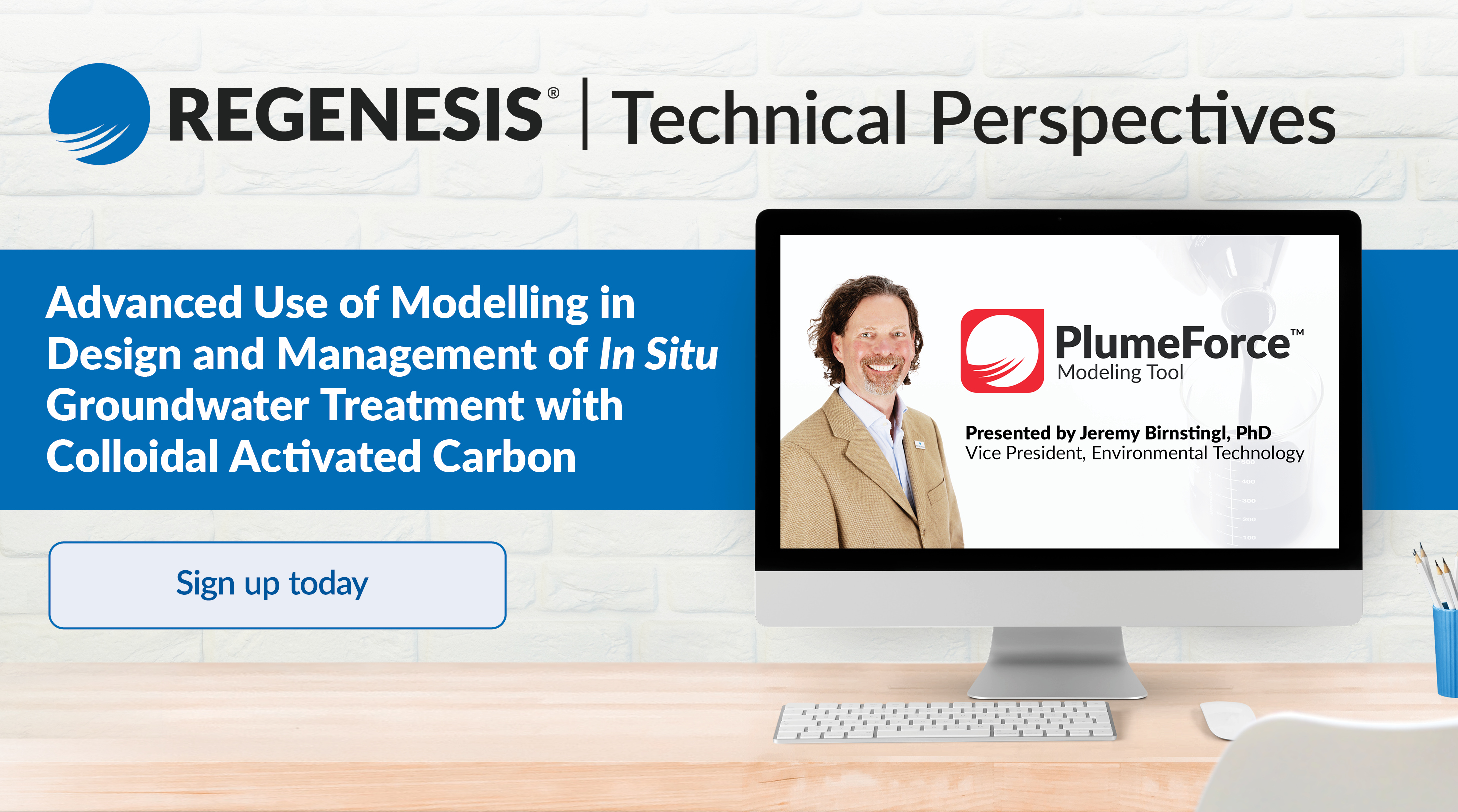REGENESIS invites you to a limited educational webinar series presented by Dr. Jeremy Birnstingl, a leading environmental expert, on the application of advanced modelling for in situ groundwater treatment using colloidal activated carbon.
This ground-breaking three-part series provides insights and examples into the power and utility of modelling to assist throughout a project, from conceptional and formal design stages to performance data interpretation, management and optimization.
The series has been developed specifically for environmental professionals focused on optimizing and better understanding best practices when developing designs to maximize the effectiveness and longevity of a remedial solution that incorporates colloidal activated carbon technology.
Part 1: PlumeStop® Colloidal Activated Carbon and Modelling
Click here to view the recording
-
Why modelling and PlumeStop are a natural match
-
How to use any model for simple PlumeStop explorations
-
The REGENESIS PlumeForce™ modelling software
-
Model-based designs
More information
Part 2: Using Modelling to Explore Hidden Processes
Click here to view the recording
-
Processes in isolation vs processes in combination – emergent phenomena
-
Kinetic equilibria – when stall is not a stall
-
Impacts of hidden mass – managing the invisible
-
Windows into hidden dynamics – implications to project design
More information
Part 3: Taking Modelling Beyond the Design
Thursday, June 22nd, 2023 | 11am pacific\2pm eastern
-
Modelling as a tool for communication support
-
Modelling as tool for managing expectations
-
Modelling to assist in performance tracking
-
Modelling to support optimization and maintenance
More information
About PlumeStop and PlumeForce Modelling Software
 PlumeStop colloidal activated carbon, a patented micron-scale amendment, has been used in the treatment of groundwater contaminant plumes for almost a decade. PlumeStop is comprised of micron-scale particles of activated carbon in liquid suspension injected into groundwater contaminant plumes. The carbon particles attach to the soil matrix and adsorb the contaminants from solution, quickly and effectively reducing contaminant concentrations, migration, and risk.
PlumeStop colloidal activated carbon, a patented micron-scale amendment, has been used in the treatment of groundwater contaminant plumes for almost a decade. PlumeStop is comprised of micron-scale particles of activated carbon in liquid suspension injected into groundwater contaminant plumes. The carbon particles attach to the soil matrix and adsorb the contaminants from solution, quickly and effectively reducing contaminant concentrations, migration, and risk.
The use of PlumeStop is often regarded as a means of capturing and immobilizing contaminants. This can be a helpful initial perspective, but it is more accurate to consider the remedial approach as a means of engineering the partitioning equilibrium (Kd) of the contaminants between the soil and the groundwater. Advanced modelling enables the wider dynamics of the process to be better understood. It also opens up the potential use of modelling as a tool to support the design and management of colloidal activated carbon projects, since Kd is a fundamental parameter of all groundwater fate and transport models.
The PlumeForce software is a modelling tool developed and used internally by REGENESIS for project design and interpretive support. At its core, it is a finite difference model that combines multi-phase biotic and abiotic degradation and transformation rates of target and non-target species with their retardation and transport within an aquifer. Competitive interactions are dynamically and quantitatively accommodated. This is particularly helpful in relation to competitive sorption / competitive displacement on activated carbon.
About the Presenter:
 Jeremy Birnstingl, BSc, PhD, FRSC, CEnv.
REGENESIS Vice President – Environmental Technology
Dr. Birnstingl serves as a senior REGENESIS technical resource on key remediation projects involving advanced in situ technologies worldwide. He is the author of the PlumeForce™ software used for design and modelling of the REGENESIS activated carbon-based technologies.
Dr. Birnstingl received a B.Sc. (Hons.) Environmental Biology from the University of Essex and a Ph.D. in Environmental Chemistry from the University of Lancaster. He is a Fellow of the Royal Society of Chemistry in the United Kingdom and a Chartered Environmentalist. He has over 30 years’ experience in the commercial and academic environmental sectors including 20 in REGENESIS. His creative and scientific insight have been recognized through three commercial patents.
Jeremy Birnstingl, BSc, PhD, FRSC, CEnv.
REGENESIS Vice President – Environmental Technology
Dr. Birnstingl serves as a senior REGENESIS technical resource on key remediation projects involving advanced in situ technologies worldwide. He is the author of the PlumeForce™ software used for design and modelling of the REGENESIS activated carbon-based technologies.
Dr. Birnstingl received a B.Sc. (Hons.) Environmental Biology from the University of Essex and a Ph.D. in Environmental Chemistry from the University of Lancaster. He is a Fellow of the Royal Society of Chemistry in the United Kingdom and a Chartered Environmentalist. He has over 30 years’ experience in the commercial and academic environmental sectors including 20 in REGENESIS. His creative and scientific insight have been recognized through three commercial patents.


